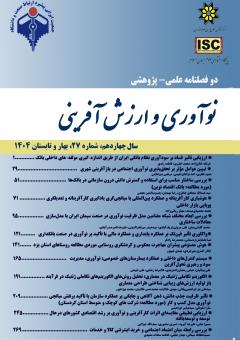ارزیابی تاثیر فساد بر سودآوری نظام بانکی ایران از طریق اندازه گیری مولفه های داخلی بانک
محورهای موضوعی : تخصصی
فرشاد خالوزاده
1
![]() ,
محمد خضری
2
*
,
محمد خضری
2
*
![]() ,
فاطمه زندی
3
,
فاطمه زندی
3
![]()
1 - دانشجوی دکتری، رشته علوم اقتصادی-اقتصاد اسلامی، دانشگاه آزاد اسلامی واحد تهران جنوب، تهران، ایران
2 - استادیار، عضو هیئت علمی دانشگاه آزاد اسلامی واحد تهران جنوب، گروه اقتصاد، تهران، ایران.
3 - استادیار، عضو هیئت علمی دانشگاه آزاد اسلامی واحد تهران جنوب، گروه اقتصاد، تهران، ایران
کلید واژه: فساد, اندازه بانک, ریسک اعتباری, مدیریت هزینه, نقدینگی بانک, سوداوری بانک,
چکیده مقاله :
در این مقاله، تأثیر فساد بر سودآوری بانکها در ایران در یک دوره ده ساله در بازه زمانی 2012 تا 2022 مورد بررسی قرار گرفته است. مولفههای مورد بررسی شامل اندازه بانک، ریسک اعتباری، مدیریت هزینه و نقدینگی است. نتایج نشان میدهد که فساد تأثیر منفی و معنیداری بر سودآوری بانکها از طریق شاخص نرخ بازده داراییها (ROA) دارد، در حالی که تأثیر معنیداری بر نرخ بازده حقوق صاحبان سهام (ROE) ندارد. عوامل اقتصادی کلان مانند تورم، آزادی اقتصادی و اندازه دولت نیز تأثیر قابل توجهی بر کاهش ROA دارند. تجزیهوتحلیل مدلها نشان میدهد که فساد ناشی از ساختار دولت و بیکاری منجر به کاهش سودآوری بانکی میشود. همچنین، نسبت نقدینگی و مدیریت هزینه رابطه مثبت و معناداری با سودآوری دارند. در نتیجه، ارتقاء شرایط نظارتی و ایجاد سیاستهای سختگیرانه برای کاهش فساد و بهبود سودآوری بانکها ضروری است. این مطالعه به شواهد تجربی ارتباط فساد و سودآوری بانکها پرداخته و بر اهمیت نظارت مؤثر تأکید دارد.
In this article, the impact of corruption on the profitability of banks in Iran over a ten-year period from 2012 to 2022 is examined. The components under review include bank size, credit risk, cost management, and liquidity. The results indicate that corruption has a significant negative impact on bank profitability through the Return on Assets (ROA) metric, while it does not have a significant impact on the Return on Equity (ROE). Macroeconomic factors such as inflation, economic freedom, and government size also significantly affect the reduction of ROA. The analysis of the models shows that corruption stemming from government structure and unemployment leads to decreased bank profitability. Additionally, liquidity ratio and cost management have a positive and significant relationship with profitability. Consequently, improving regulatory conditions and implementing strict policies to reduce corruption and enhance bank profitability is essential. This study provides empirical evidence on the relationship between corruption and bank profitability and emphasizes the importance of effective oversight

